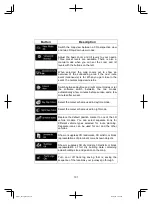
107
6 Glossary
2D/3D GPS reception
The GPS receiver uses satellite signals to calculate its (your) position and
needs at least four signals to give a three-dimensional position, including
elevation. Because the satellites are moving and because objects can block
the signals, your GPS device might not receive four signals. If three
satellites are available, the receiver can calculate the horizontal GPS
position but the accuracy is lower and the GPS device does not give you
elevation data: only 2D reception is possible.
Active route
The currently navigated route. Whenever the destination is set, the route is
active until you delete it or you reach your destination. See also: Route.
City Centre
The city/town centre is not the geometric centre of the city/town but an
arbitrary point the map creators have chosen. In towns and villages, it is
usually the most important intersection; in larger cities, it is one of the
important intersections.
GPS accuracy
Several factors have impact on the deviation between your real position and
the one given by the GPS device. For example, signal delay in the
ionosphere or reflecting objects near the GPS device have a different and
varying impact on how accurately the GPS device can calculate your
position.
Map
The software works with digital maps which are not simply the
computerised versions of traditional paper maps. Similarly to the paper road
maps, the 2D mode of digital maps show you streets, roads, and elevation
is also shown by colours.
In 3D mode, you can see the altitude differences, for example valleys and
mountains, elevated roads, and in selected cities 3D landmarks and 3D
buildings are also displayed.
Alpine_X009E_B5.pdf 107
5/9/2014 14:22:26






































